
 |
|
Dive World War II Aircrafts (www.DiveSriLanka.com)
A Japanese Zero or a British Hawker Hurricane or?
Trincomalee Harbour
Depth: 24.2 MetersBy Dharshana Jayawardena on the 07/09/2013
|
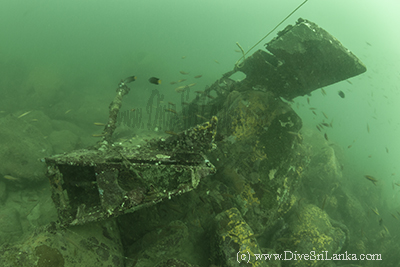 Site 1: Pieces of wing |
|||
07/09/2013 - It is the 9th of April 1942 and a storm of fury is descending upon the terrified island of Ceylon. Some 800 Kilometers south east of the island, a full fledged Japanese carrier group is making its way towards the country at full speed. This armada headed by the Japanese Admiral Chuichi Nagumo consists of six Aircraft carriers, four battleships, five submarines, seven cruisers, 19 destroyers and 350 aircraft! One of their targets is the town of Trincomalee, famed world wide for its massive natural harbour, the second largest natural harbour of its kind. Just four days earlier, on Easter Sunday, the Ceylonese capital city of Colombo had been subjected to a brutal air raid by a swarm of Mitsubishi A06 Zero Fighters. Ever since, the citizens of this tiny island, shaken by the collapse of its flimsy defences erected by its imperial British colonial masters, lived a jittery existence of many sleepless nights expecting the fierce onslaught of a fearsome Japanese Imperial Army. And now their worst fears seemed to be coming true. At 7.00 AM, the Japanese unleashed their first attack on Trincomalee with ninety one bombers and thirty eight fighter aircraft. However in contrast to the Sunday's raid, the RAF at China Bay had received some advanced warning and already had a meagre aerial force scouring the skies for enemy aircraft. But it proved to be no avail. The fierce dog fight that ensued over the skies of Trincomalee that day claimed countless lives in air, sea and ground with damage to fuel installations, ammunition dumps, vehicles on the ground, ships at the harbour and air craft that dropped from the sky like flaming meteors. One Japanese pilot is claimed to have committed suicide by crashing his plane into one of the Navy's massive British oil storage tanks which happened to be fully filled at that time. This plane was later verified to be a Type 97 Kate Bomber which was shot down by ground fire. The tank it crashed on to supposedly burnt for days and can still be seen today including some remains of the aircraft. Many of the other air craft from both sides of the fight fell into the deep Trincomalee Harbour. They included Japanese Zero's as well as six Hawker Hurricanes and one Fairey Fulmer. At 24 Meters depth, in the Trincomalee Harbour, we are now about to dive into one such air craft. It is hardly of its former self; remnants scattered over two sites close by over the rocks. One site appears to be pieces of wing while the other the main air frame. It is supposedly a Japanese Zero. But doubts remain based on its size and shape. There is a high probability that this is one of the eight Hawker Hurricanes that crashed into the Harbour. Even though this is a very small site, it is an interesting dive; In a sense, a dive to the past, to remind ourselves of the five terrifying days in 1942 when the World War II finally came to Ceylon. (This dive site is only accessible through the Sober Island Resort within the Trincomalee Naval Bay. The one of a kind resort is owned and run by the Sri Lankan Navy. Click here for more information)
|
||||
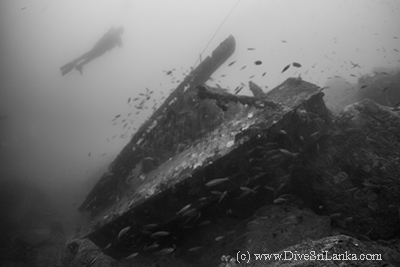 Debris field in Site 1 |
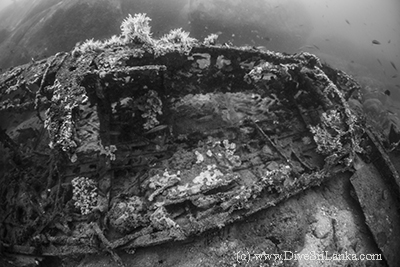 Site 2: Tail side of the main air frame |
|||
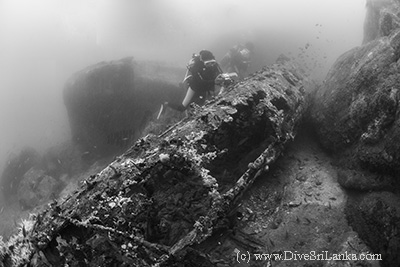 Site 2: Diver over the main air frame |
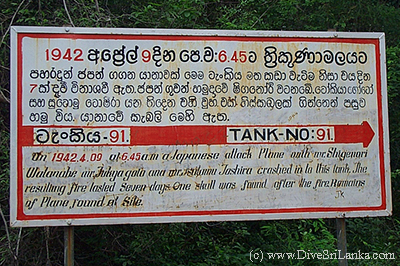 Where one of the Japanese Aircraft crashed into the Oil Tanks |
|||
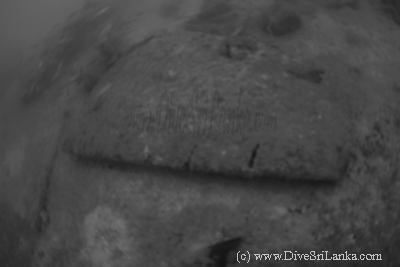 |
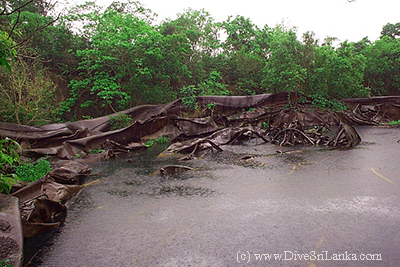 All that remains of a massive oil tank that burnt fiercely after the crash |
|||
| Wing? | ||||
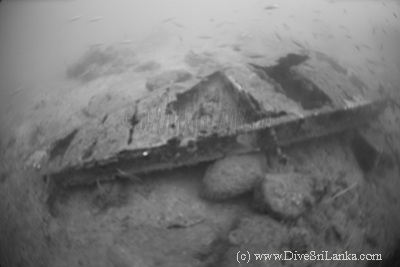 Part of the Wing1 |
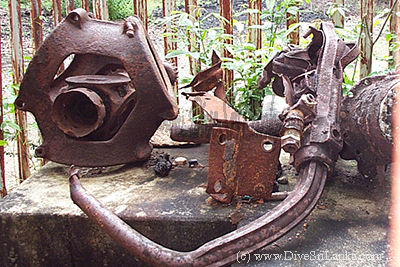 What's left of a three crew Type 97 Kate Bomber |
|||
|
Photo Credits: (c) www.DiveSriLanka.com by Dharshana Jayawardena |
||||